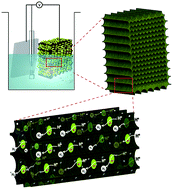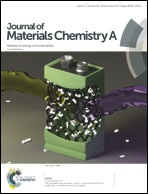Aligned and stable metallic MoS2 on plasma-treated mass transfer channels for the hydrogen evolution reaction†
Abstract
Ultra-thin molybdenum disulfide (MoS2) nanosheets have attracted intensive attention due to their catalytic properties. However, most of the previously described MoS2 nanosheets show poor electrical conductivity and a limited amount of active sites. Moreover, these nanosheets tend to restack severely due to van der Waals forces causing a reduction in the density of their active sites. Inspired by nature, for the first time, we have vertically grown 1T metallic MoS2 on well-aligned, freestanding, 1000 μm long channels obtained from carbonized wood to maximize the exposition of active catalytic sites and increase the electrolyte and hydrogen transport through the well-aligned channels using a scalable approach. Furthermore, the carbonized wood surface was plasma treated to assist the dissipation of generated hydrogen, thus reducing the proton transport barrier at the electrode surface. The vertically grown 1T metallic MoS2 on thoroughly aligned long carbonized wood channels exhibits remarkable catalytic activity with an operating overpotential of 128 mV at a current density of 10 mA cm−2. This work provides a new approach for 1T metallic MoS2 synthesis and an interesting configuration to optimize and maintain the active catalytic sites and dissipate hydrogen on time by in situ vertically grown catalyst on the well-aligned channels made by nature.



 Please wait while we load your content...
Please wait while we load your content...